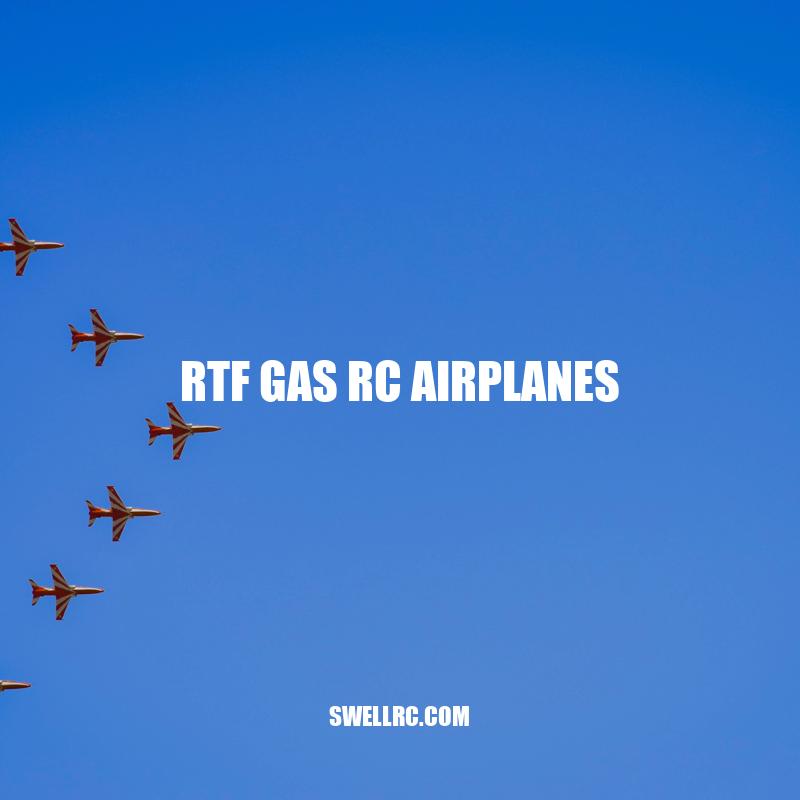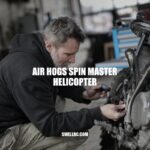RTF Gas RC Airplanes: The Ultimate Guide
Radio-controlled (RC) airplanes have been a popular hobby for enthusiasts of all ages, and it’s easy to see why. The thrill of flying an aircraft without being in it, the engineering and building process of the model, and the community that surrounds it are just some of the reasons why so many people have fallen in love with this pastime. Perhaps one of the most exciting types of RC airplanes is those that run on gas or nitro engines, known as RTF (Ready-to-Fly) gas RC airplanes. These aircraft offer the realism of flying a gas-powered aircraft without the risk and expense of owning a full-size airplane. In this article, we will explain everything you need to know about RTF gas RC airplanes, including their designs, features, assembly, flying techniques, and maintenance. Whether you are a seasoned RC airplane hobbyist or a beginner, this guide will be a valuable resource for you. So, buckle up and let’s dive into the world of RTF gas RC airplanes.
The Design of RTF Gas RC Airplanes
RTF gas RC airplanes are designed to mimic the look and feel of a real aircraft. They are built with lightweight and durable materials such as balsa wood and fiberglass to ensure maximum flight time and efficiency. Here are some of the key design aspects of RTF gas RC airplanes:
- Wings: Wings are the most vital part of the airplane as they provide lift and help to stabilize the flight. They are built with a variety of shapes and sizes depending on the type of airplane and its intended use.
- Fuselage: The fuselage is the central section of the airplane that houses the engine, fuel tank, and other components. It is designed to be aerodynamic to lessen wind resistance in flight.
- Tail: The tail of the airplane consists of a horizontal stabilizer, which provides stability, and a vertical stabilizer that helps with direction and control.
- Engine: RTF gas RC airplanes are powered by gas or nitro engines that range in size and power. The engine is often mounted on the front of the airplane to provide maximum thrust during flight.
Depending on the type of RC airplane, it may have additional design features, such as retractable landing gear or wing flaps, that aid in flying and maneuvering. Some popular brands of RTF gas RC airplanes include Hangar 9, FMS, and Top Flite. For more information on available models and designs, visit websites such as Horizon Hobby or Tower Hobbies.
What is RTF in RC planes?
RTF stands for Ready-To-Fly and it means that an RC plane comes fully assembled and includes everything needed to fly right out of the box. Typically, RTF planes include a pre-installed motor, speed controller, and radio system.
There are many websites that offer RTF RC planes for sale, including Horizon Hobby, Tower Hobbies, and HobbyKing. Some popular RTF planes on the market include the HobbyZone Sport Cub S and the Hobbico Flyzone Sensei FS.
If you’re new to RC planes and want a convenient and hassle-free option, RTF planes are a great choice. They are also a good option for those who don’t have the time or expertise to assemble a plane themselves.
Features and Components of RTF Gas RC Airplanes
RTF gas RC airplanes are equipped with various components that make them functionally advanced and exciting to operate. Here are some of the key features of RTF gas RC airplanes:
- Remote control: RTF gas RC airplanes use a remote control to operate its components such as the engine, flaps, and other electronic parts
- Receiver: The receiver is the component that receives signals from the remote transmitter and translates them to the servo to move the control surfaces such as ailerons, rudder and elevator.
- Servo: The servo is a small motor that moves the control surfaces of the airplane in response to the signals from the remote transmitter
- Gyro stabilizer: It provides stability during flight, reducing the effects of wind gusts and turbulence
- Battery: The battery powers the electronic components of the plane. High-capacity lithium polymer batteries are common to run electronic components and also provide thrust in electric-powered airplanes.
- Fuel tank: The fuel tank stores gasoline or nitro fuel to power the engine. It is essential to check the fuel before flight.
In addition to these components, RTF gas RC airplanes also come equipped with auxiliary features such as landing gear, lights, and emergency parachutes. A popular type of RTF gas RC airplane is the Warbird models that replicate vintage military planes. In 2018, a Guinness World Record was set in Oregon, USA, for the most number of RC airplanes flown at the same time, with 2,201 airplanes taking off.
If you are looking to purchase an RTF gas RC airplane, popular websites such as Amazon or B&H Photo Video offer a wide range of models to choose from. Here is a table comparing some of the popular RTF gas RC airplanes currently available on the market:
| Brand | Model | Wingspan | Engine | Price |
|---|---|---|---|---|
| HobbyZone | Champ RTF | 20.3 inches | Electric | $89.99 |
| FMS | P-51D Mustang | 57 inches | Gasoline | $589.99 |
| Phoenix | Extra 300S | 90.5 inches | Gasoline | $1,399.99 |
What is the best fuel for RC planes?
The best fuel for RC planes is dependent on the type of engine in the aircraft. Below are the two typical types of fuel for RC planes:
- Nitro methane fuel mix: It is commonly used for glow engines and is a mixture of methanol, synthetic oil, and nitro methane. These engines require 10-30% nitro methane, and the fuel must be handled with care as it is toxic and highly flammable.
- Gasoline: Gasoline-powered engines run on pure gasoline and require a larger tank for longer flights. They tend to be more fuel-efficient than glow engines, and gas fuel is much easier to handle and is less toxic than nitro methane.
It’s important to note that not all fuels are created equal, and it’s essential to choose high-quality fuel for your RC planes. Websites like Tower Hobbies and Nitroplanes offer a wide selection of fuel options and have a reputation for providing high-quality products.
Assembly and Tuning of RTF Gas RC Airplanes
The assembly and tuning of an RTF gas RC airplane is an important process to ensure that the plane is set up correctly and operates optimally. Here are some tips for assembling and tuning an RTF gas RC airplane:
- Read the instruction manual: It’s essential to read and understand the instruction manual before starting to assemble the RTF gas RC airplane.
- Check all components: Check all components of the RC airplane for any damage or defects before assembling.
- Balance the propeller: Balancing the propeller is essential to reduce vibration and ensure a smooth flight.
- Set the control surfaces: Set the control surfaces such as ailerons, rudder, and elevator to the desired angle as per the instruction manual.
- Tune the engine: Tuning the engine is essential to improve the performance of an RTF gas RC airplane. Here is the list of adjustment you can do:
- Adjust the Air-Fuel mixture: This consists of a low-speed needle and a high-speed needle adjusted to supply the right proportion of fuel and air to the engine at different stages of flight.
- Adjust the Idle Speed: Set the idle speed so the engine does not shut off during flight or on the ground.
- Test the plane: Before flying, perform a full range of checks to make sure everything is working correctly.
There are various resources available online, including YouTube tutorials and forums, to assist you in assembling and tuning your RC airplane. If you are looking for specific parts or accessories for your RTF gas RC airplane, websites such as HobbyKing and Tower Hobbies offer a range of options for hobbyists.
How to tune an RC airplane engine?
Tuning an RC airplane engine can be a tricky task, but with the right steps, it can be done effectively. Here are the basic steps to tuning an RC airplane engine:
- Firstly, make sure the engine is properly broken in before attempting to tune it
- Start by adjusting the high-speed needle, turning it until the engine runs smoothly at maximum throttle
- Next, adjust the low-speed needle to achieve a smooth idle
- Then, adjust the idle needle to get a steady and consistent idle
- Ensure that the fuel mixture is proportioned correctly, according to the manufacturer’s instructions
- Lastly, perform small adjustments to the carburetor as needed to fine-tune the engine’s performance
It’s important to note that tuning may differ depending on the type of engine and model of the RC airplane. Consult the manufacturer’s instructions or a trusted RC website for specific guidance.
Some helpful products for tuning an RC airplane engine include tuning screwdrivers, assorted needles and a tachometer to ensure the engine’s RPM is within the proper range.
Flying RTF Gas RC Airplanes
Flying an RTF gas RC airplane is a thrilling experience. However, safety always comes first. Here are some tips to keep in mind when flying your RC airplane:
- Choose the right location: Choose an open space away from power lines, buildings, and populated areas to fly your RC airplane.
- Check the weather: Fly only in good weather and clear skies.
- Charge the batteries: Ensure that the batteries are charged before taking off.
- Perform a pre-flight check: Check all components and parts of the RC airplane such as control surfaces, engine, and fuel tanks to ensure everything is working correctly.
- Take off: Gradually increase the throttle until the RC airplane lifts off the ground and gains altitude.
- Maintain control: Always be in control of the RC airplane and maintain a safe distance from other aircraft or obstacles.
- Landing: Reduce the throttle and lower the nose gently to land the RC airplane.
There are several communities and forums online where RC hobbyists share tips and tricks on flying their RTF gas RC airplanes. These sites include RCGroups and RC Universe. Additionally, websites such as Amazon and Horizon Hobby offer various products like RC airplane starter kits, batteries, propellers, and controllers.
Is it hard to fly remote control plane?
Flying a remote control plane can be challenging, especially for beginners. However, with practice and commitment, anyone can learn to fly one. Here are a few tips that can help:
- Start with a basic trainer plane designed for beginners
- Read the manual and understand the controls
- Join a local flying club for guidance and instruction
- Practice on a simulator or with a buddy box system before flying solo
- Find an open, safe space to fly
There are many websites and products that can help you learn how to fly RC planes. Some popular options include:
| Website | Product |
|---|---|
| RCGroups.com | Online community and forums |
| HobbyKing.com | Remote control planes, simulators, and accessories |
| RealFlight.com | Flight simulator software |
Remember, learning to fly an RC plane takes time and patience. Don’t get discouraged if it takes a while to get the hang of it. With dedication and persistence, you’ll be flying like a pro in no time!
Maintenance and Repair
Maintaining and repairing your RTF gas RC airplane is essential to keep it in top condition and prolong its lifespan. Here are some maintenance tips to consider:
- Inspect the airplane after each flight: Look for signs of wear and tear on the components, such as cracks or bends on the wings or control surfaces.
- Clean the airplane: Dust or dirt can clog the engine and decrease its performance. Use a soft brush or cotton swab to clean the surface of the components and remove dirt buildup.
- Check the fuel tank: Ensure that the fuel tank is clean and free from any debris or contamination.
- Replace worn-out parts: Always replace parts that are showing signs of wear and tear.
If you encounter any problems with your RC airplane, you can troubleshoot and repair it using online resources. Horizon Hobby provides manuals and guides for their products, and there are numerous YouTube tutorials available. In addition, RC Universe and RC Groups have forums where members share their experiences and help each other out with troubleshooting and repairing their RC airplanes. Lastly, you can purchase maintenance and repair kits from Amazon or your local hobby store to help upkeep your RTF gas RC airplane.
Conclusion
In conclusion, RTF gas RC airplanes are a great option for hobbyists who are looking for a thrilling and exciting experience. With their realistic design, powerful engines, and high-speed capabilities, the aircraft provides an unparalleled experience that’s loved by enthusiasts worldwide.
Whether you’re a beginner or an experienced pilot, there’s always something to learn and explore in the world of RTF gas RC airplanes. While there may be a learning curve, it is worth investing the time and effort to master the art of flying the aircraft.
With proper maintenance and care, your RTF gas RC airplane can provide years of enjoyment and fun. As with any hobby, it is essential to put safety first, carefully follow instructions on assembly and tuning, and take necessary precautions prior to flying.
In summary, the RTF gas RC airplane is a worthwhile investment for anyone looking to explore the world of RC aviation, with endless opportunities for creativity, learning, and enjoyment.



